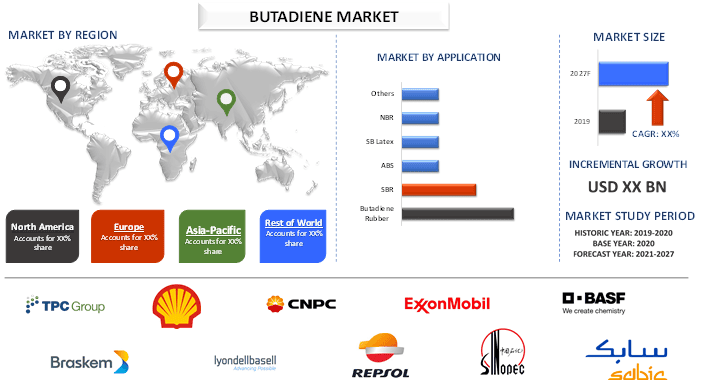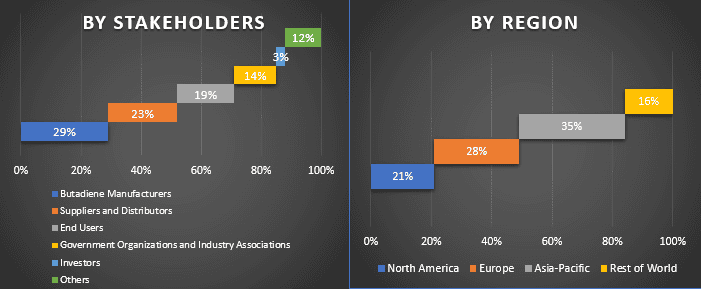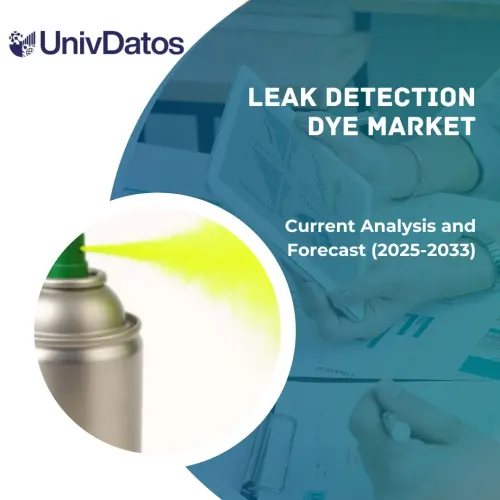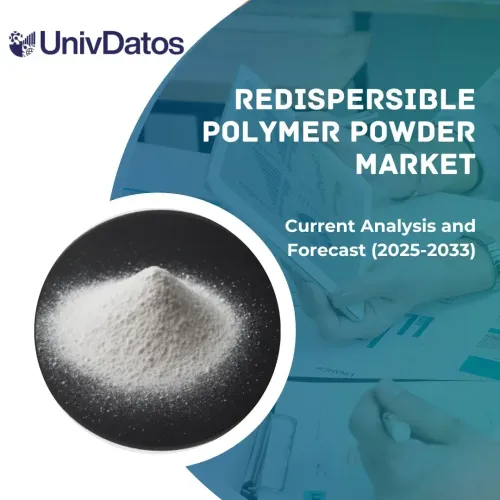- Home
- About Us
- Industry
- Services
- Reading
- Contact Us
Butadiene Market: Current Analysis and Forecast (2021-2027)
Emphasis on Application (Butadiene Rubber, Styrene-Butadiene Rubber (SBR), Acrylonitrile Butadiene Styrene (ABS), Styrene-Butadiene Latex (SB Latex), Acrylonitrile-Butadiene Rubber (NBR), and Others); and Region and Country

The global Butadiene market is expected to demonstrate the growth of ~4% during the forecast period (2021-2027). Butadiene is an important primary raw material in the manufacturing of synthetic rubbers. Rubbers including SBR, SBS, and butadiene rubber are some of the commonly used synthetic rubber in which butadiene constitute a major portion. The aforementioned rubbers are widely utilized in the manufacturing of several products like shoe soles, tires, and other parts for the car industry, adhesives and sealants, asphalt and polymer modification and compounds for endless purposes. Therefore, with increasing demand for such products demand of butadiene eventually increases to support and suffice the requirement of growing end use industry.
However, industry witnessed severe challenges in 2020 due to COVID-19, resulted in the decline demand from rubber manufacturing industry. For instance, in 2019, the global original equipment manufacture passenger car and light truck tire market was stood around 422 million units which fell to 351 million unit in 2020. The most severe impact had witnessed in South American region where demand dropped by 31% in 2020. This fall in tire sales, reduced the demand of synthetic rubber, so does the butadiene.
Insights Presented in the Report
“Amongst application, SBR held prominent share in the market in 2020.”
Based on application, the market is categorized into butadiene rubber, SBR, ABS, SB latex, NBR, and others. Among these, SBR held the prominent share in the global Butadiene market. SBR is widely use in tire industry as it is better suited to meet the increasingly stringent specifications of high-performance tires. Further, in automotive industry SBR founds application in belt, hoses, gasket. Therefore, growth in tire industry and replacement of automotive components are some of the key factors for its considerable position in the market.
“Large base of manufacturing industries propels the demand of butadiene in the APAC region”
For a better understanding of the market adoption of Butadiene, the market is analyzed based on its worldwide presence in the countries such as North America (United States, Canada, Rest of North America), Europe (Germany, UK, France, Spain, and Rest of Europe), Asia-Pacific (China, Japan, India, Australia, and Rest of APAC), and Rest of World. Asia-Pacific held the prominent position in the global Butadiene market owing to its large tire manufacturing industry and largest automobile production base across the globe. For instance, tire manufacturers like Bridgestone, Yokohama, Kumho, Hankook, Triangle, Apollo, and MRF are among the largest producer of tire, globally. Further, the regional is the largest producer footwear in the world, with country like China, Vietnam, Indonesia, and India has considerable market share. Therefore, region has large number of synthetic rubber manufacturing facilities in order to make a strong supply chain and take advantage of lower manufacturing cost. As a result, high consumption of butadiene by these facilities.
Reasons to buy this report:
- The study includes market sizing and forecasting analysis validated by authenticated key industry experts
- The report presents a quick review of overall industry performance at one glance
- The report covers in-depth analysis of prominent industry peers with a primary focus on key business financials, product portfolio, expansion strategies, and recent developments
- Detailed examination of drivers, restraints, key trends, and opportunities prevailing in the industry
- The study comprehensively covers the market across different segments
- Deep dive country level analysis of the industry
Customization Options:
The global Butadiene market can further be customized as per the requirement or any other market segment. Besides this, UMI understands that you may have your own business needs, hence feel free to connect with us to get a report that completely suits your requirements.
Table of Content
Analyzing the historical market, estimation of the current market, and forecasting the future market of the Butadiene three major steps undertaken to create and analyze its adoption across the globe. Exhaustive secondary research was conducted to collect the historical market numbers and estimate the current market size. Secondly, to validate these insights, numerous findings and assumptions were taken into consideration. Moreover, exhaustive primary interviews were also conducted, with industry experts across the value chain of the Butadiene industry. Post assumption and validation of market numbers through primary interviews, we employed a bottom-up approach to forecast the complete market size. Thereafter, market breakdown and data triangulation methods were adopted to estimate and analyze the market size of segments and sub-segments the industry pertains to. Detailed methodology is explained below:
Analysis of Historical Market Size
Step 1: In-Depth Study of Secondary Sources:
Detail secondary study was conducted to obtain the historical market size of the Butadiene through company internal sources such as annual report & financial statements, performance presentations, press releases, etc., and external sources including journals, news & articles, government publications, competitor publications, sector reports, third-party database, and other credible publications.
Step 2: Market Segmentation:
After obtaining the historical market size of the Butadiene market, we conducted a detailed secondary analysis to gather current market insights and share for different segments & sub-segments for major regions. Major segment included in the report is by application. Further regional and country-level analyses were conducted to evaluate the overall adoption of the Butadiene globally.
Step 3: Factor Analysis:
After acquiring the historical market size of different segments and sub-segments, we conducted a detailed factor analysis to estimate the current market size of Butadiene. Further, we conducted factor analysis using dependent and independent variables such as increasing demand of synthetic rubber and opening of new application like electric vehicles. A thorough analysis was conducted for demand and supply-side scenario considering increasing investment, top partnerships, merger and acquisition, business expansion, and product launches in the Butadiene industry.
Current Market Size Estimate & Forecast
Current Market Sizing: Based on actionable insights from the above 3 steps, we arrived at the current market size, key players in the global Butadiene market, and market shares of each segment. All the required percentage shares split, and market breakdowns were determined using the above-mentioned secondary approach and were verified through primary interviews.
Estimation & Forecasting: For market estimation and forecast, weights were assigned to different factors including drivers & trends, restraints, and opportunities available for the stakeholders. After analyzing these factors, relevant forecasting techniques i.e., bottom-up approach was applied to arrive at the market forecast to 2027 for different segments and subsegments across the major regions globally. The research methodology adopted to estimate the market size encompasses:
- The industry’s market size, in terms of value (US$) and the adoption rate of Butadiene across the major markets
- All percentage shares, splits, and breakdowns of market segments and sub-segments
- Key players in the Butadiene market in terms of revenue generated. Also, the growth strategies adopted by these players to compete in the fast-growing market.
Market Size and Share Validation
Primary Research: In-depth interviews were conducted with the Key Opinion Leaders (KOLs) including Top Level Executives (CXO/VPs, Sales Head, Marketing Head, Operational Head, and Regional Head, Country Head, etc.) across major regions. Primary research findings were then summarized, and statistical analysis was performed to prove the stated hypothesis. Inputs from primary research were consolidated with secondary findings, hence turning information into actionable insights.
Split of Primary Participants in Different Regions

Market Engineering
Data triangulation technique was employed to complete the overall market estimation and to arrive at precise statistical numbers of each segment and sub-segment of the global Butadiene market. Data was split into several segments & sub-segments post studying various parameters and trends in the area of application.
The main objective of the Butadiene market study
The current & future market trends of global Butadiene were pinpointed in the study. Investors can gain strategic insights to base their discretion for investments from the qualitative and quantitative analysis performed in the study. Current and future market trends would determine the overall attractiveness of the market at a country level, providing a platform for the industrial participant to exploit the untapped market to benefit as a first-mover advantage. Other quantitative goals of the studies include:
- Analyze the current and forecast market size of Butadiene in terms of value (US$). Also, analyze the current and forecast market size of different segments and sub-segments
- Segment in the study include area of application
- Defined analysis of the regulatory framework for the Butadiene industry
- Analyze the value chain involved with the presence of various intermediaries, along with analyzing customer and competitor behaviors of the industry
- Analyze the current and forecast market size of the Butadiene for the major countries
- Major regions/countries analyzed in the report includes North America (US, Canada, Rest of North America), Europe (Germany, UK, France, Spain, Rest of Europe), Asia-Pacific (China, Japan, India, Australia, Rest of Asia-Pacific), and Rest of World
- Company profiles of the Butadiene market players and the growth strategies adopted by them to sustain in the growing market
- Deep dive country level analysis of the industry
Related Reports
Customers who bought this item also bought










